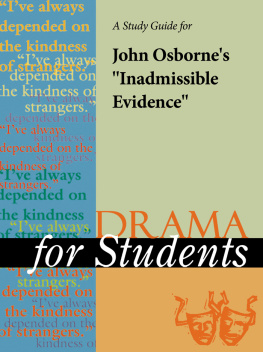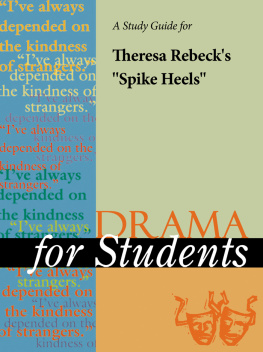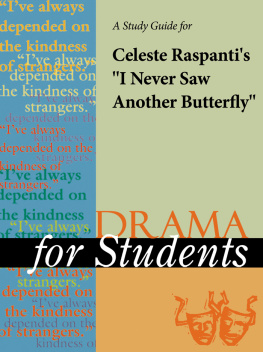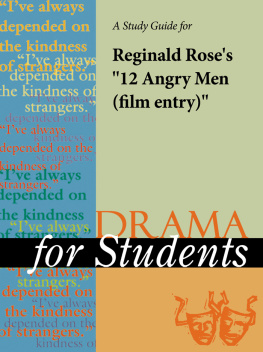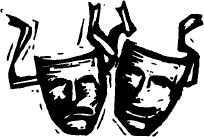Drama for Students, Volume 1
STAFF
David Galens and Lynn M. Spampinato, Editors
Thomas Allbaugh, Craig Bentley, Terry Browne, Christopher Busiel, Stephen Coy, L. M. Domina, John Fiero, Carol L. Hamilton, Erika Kreger, Jennifer Lewin, Sheri Metzger, Daniel Moran, Terry Nienhuis, Bonnie Russell, Arnold Schmidt, William Wiles, Joanne Woolway, Contributing Writers
Elizabeth Cranston, Kathleen J. Edgar, Joshua Kondek, Marie Lazzari, Tom Ligotti, Marie Napierkowski, Scot Peacock, Mary Ruby, Diane Telgen, Patti Tippett, Kathleen Wilson, Pam Zuber, Contributing Editors
Pamela Wilwerth Aue, Managing Editor
Jeffery Chapman, Programmer/Analyst
Victoria B. Cariappa, Research Team Manager
Michele P. LaMeau, Andy Guy Malonis, Barb McNeil, Gary Oudersluys, Maureen Richards, Research Specialists
Julia C. Daniel, Tamara C. Nott, Tracie A. Richardson, Cheryl L. Warnock, Research Associates
Susan M. Trosky, Permissions Manager
Kimberly F. Smilay, Permissions Specialist
Sarah Chesney, Permissions Associate
Steve Cusack, Kelly A. Quin, Permissions Assistants
Mary Beth Trimper, Production Director
Evi Seoud, Assistant Production Manager
Shanna Heilveil, Production Assistant
Randy Bassett, Image Database Supervisor
Mikal Ansari, Robert Duncan, Imaging Specialists
Pamela A. Reed, Photography Coordinator
Cynthia Baldwin, Product Design Manager
Cover design: Michelle DiMercurio, Art Director
Page design: Pamela A. E. Galbreath, Senior Art Director
Since this page cannot legibly accommodate all copyright notices, the acknowledgments constitute an extension of the copyright notice.
While every effort has been made to secure permission to reprint material and to ensure the reliability of the information presented in this publication, Gale Research neither guarantees the accuracy of the data contained herein nor assumes any responsibility for errors, omissions, or discrepancies. Gale accepts no payment for listing; and inclusion in the publication of any organization, agency, institution, publication, service, or individual does not imply endorsement of the editors or publisher. Errors brought to the attention of the publisher and verified to the satisfaction of the publisher will be corrected in future editions.
This publication is a creative work fully protected by all applicable copyright laws, as well as by misappropriation, trade secret, unfair competition, and other applicable laws. The authors and editors of this work have added value to the underlying factual material herein through one or more of the following: unique and original selection, coordination, expression, arrangement, and classification of the information.
All rights to this publication will be vigorously defended.
Copyright 1998
Gale Research
835 Penobscot Building
645 Griswold St.
Detroit, MI 48226-4094
All rights reserved including the right of reproduction in whole or in part in any form.
This book is printed on acid-free paper that meets the minimum requirements of American National Standard for Information SciencesPermanence Paper for Printed Library Materials, ANSI Z39.48-1984.
ISBN 0-7876-1683-4
ISSN applied for and pending
Printed in the United States of America
10 9 8 7 6 5 4 3
She Stoops to Conquer
Oliver Goldsmith
1773
Introduction
Most everyone has been the target of practical jokes, and most have been out on blind dates. Oliver Goldsmith bases his 1773 comedy She Stoops to Conquer on two such incidents, creating a complicated, convoluted plot based on miscommunication and mistaken identities. At the same time, Goldsmith explores a series of ethical and aesthetic issues.
Audiences responded favorably to She Stoops to Conquer when Goldsmiths play debuted in 1773 and have continued to do so ever since. Significantly, from its debut, it earned popular approval and remains today one of the few 18th century plays to be regularly performed for modern audiences. While the play proves funny and entertaining, it also marks an important step in the development of comic theory. Significantly, Goldsmiths play changed the face of comic theatre, eclipsing the popular sentimental comedy of the day, and inaugurated a new style of laughing comedy.
For those who believe the plays plot seems too far-fetched, Oscar James Campbell noted in an introduction to Chief Plays of Goldsmith and Sheridan: The School for Scandal, She Stoops to Conquer, The Rivals that the central idea of She Stoops to Conquer was suggested to Goldsmith by an incident of his boyhood. He had been told that the house of a Mr. Featherstone was an inn and directed there for entertainment. Goldsmith, always easily deceived by a practical joke, had gone to the squires house and treated him as a host. Out of this situation grew his characters and their games of cross-purposes. Other autobiographical elements in the play include resemblances between the young, vagabond Goldsmith who spent two years on a walking tour of Europe and the irresponsible, irrepressible Tony Lumpkin. Finally, Goldsmith, like his character Marlow, was at ease with serving women, but stiff in the company of proper ladies, in part because of insecurities about his physical appearance.
Author Biography
Born November 10, 1728, in Ballymahon, Ireland, Goldsmith was from a poor but not needy family, supported by his fathers position as a minister. The family had expected that Goldsmith would attend university, but the marriage of an older sister required his tuition money as part of her sizable dowry. In 1745, Goldsmith entered Trinity College in Dublin under the sizar system, which allowed poor students to study in exchange for work. Perhaps because of his tenuous economic circumstances, Goldsmith did not distinguish himself academically. He failed to take his studies entirely seriously, violated college rules, and even took part in a riot in which several people died.
Completing his B.A. in 1749, Goldsmith attempted various careers, including the ministry and medicine. From 1753-56, he wandered across the British continent before arriving in London. There, Goldsmith embarked on a career writing reviews and essays for such periodicals as Ralph Griffiths Monthly Review and Tobias Smolletts Critical Review, as well as proofreading for the novelist and printer Samuel Richardson.
The first book to appear under Goldsmiths name proved a notable success. Entitled The Citizen of the World; or, Letters from a Chinese Philosopher Residing in London to His Friends in the East, it began as a series of essays in the Publick Ledger. Goldsmith, masquerading under the identity of an Asian visitor, satirized the faults and foibles of fashionable London society. The work brought Goldsmith to the attention of the citys literary elite, particularly members of The Club, which included writers like Samuel Johnson, James Boswell, Edmund Burke, and Thomas Percy, the painter Sir Joshua Reynolds, and the actor David Garrick. The work also brought Goldsmith literary opportunities, but poor money management drove him to hack writing for survival, a pattern that unfortunately continued throughout his life.



